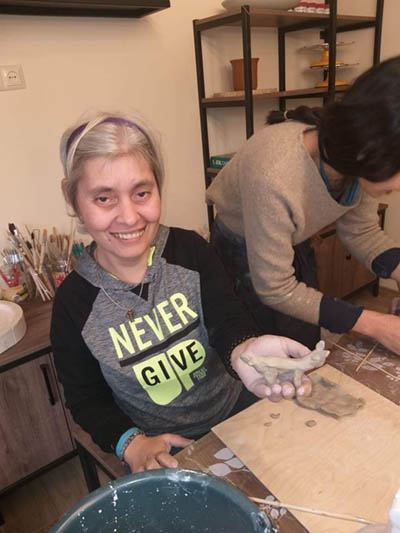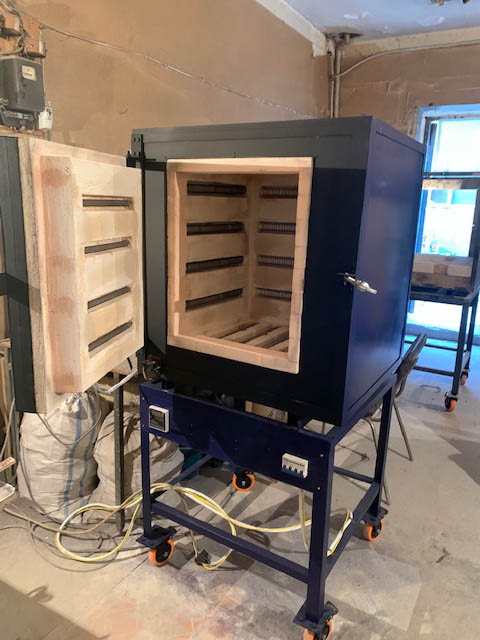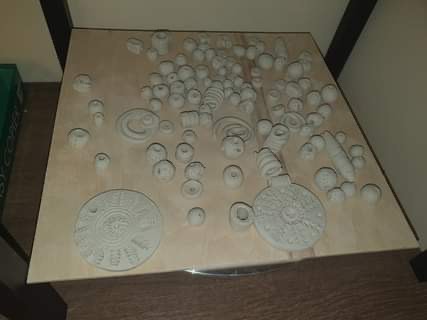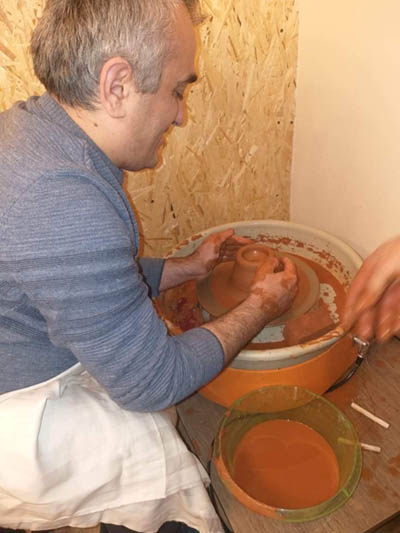
The ceramics lab in Geghanist, Armenia,
brings joy to the residents of the Warm Hearths homes.
Ceramics Lab for People with Special Needs
by Muriel Mirak-Weissbach
GEGHANIST, Armenia, FEBRUARY 24, 2021 — “It seems that our dreams have come true!”
This is how Alya Kirakosyan put it when the ceramics lab opened this month. Kirakosyan is the director of Warm Hearth, a house in the village of Geghanist in Ararat marz, not far from Yerevan. The house there shelters adult orphans, many but not all are women; all are graduates of special orphanages for people with special needs.

The ceramics lab in Geghanist, Armenia,
rings joy to the residents of the Warm Hearths homes.
There are three such houses in Armenia: in addition to this one in Geghanist, there is one on the outskirts of the capital, and another in the village of Arinj (Kotayk marz). The residents are all adults with different levels of mental disability. All three houses are family type establishments, offering permanent residence to these individuals, who, although they are not able to work to earn a living, can learn to perform useful activities. The houses have social workers and caregivers who teach the residents basic household skills; then there is therapy, including in arts and crafts, and here is where the ceramics lab comes into the picture.
The new ceramics lab is a joint project set up by the Fund for Armenian Relief (FAR) in partnership with the Mirak-Weissbach-Stiftung, a small foundation in Germany.
Kirakosyan described the excitement of the residents and staff: “We have been longing for this project for some time. The pottery project has not only a therapeutic significance for our residents, but will help us fulfill our goals in social entrepreneurship.”

The special ceramics oven
She explained the special qualities of this kind of therapy, which make it so important. “Clay is a living material,” she said, “and has a calming effect, which is one reason why it is so widely used in art therapy. For those who have problems with manual control, clay is something that is easy to work with and does not require advanced skills.” She said the students were now concentrated on their assignments and look forward to presenting the first fruits of their labors soon.
Margarit Piliposyan, deputy country director and programs director of FAR, has extensive experience with Warm Hearths. “The three houses are run by a local foundation which has a sister organization in the US,” she explained, “Friends of Warm Hearth is their name. They support the costs for dignified living of all the residents, and the national budget provides some financial support as well. But the organization has to fundraise to finance therapy, vocational training and entertainment.”
There are 30 adult orphans with disabilities who benefit from the project. They have classes twice a week of an hour and half each. The ceramics lab is a boon for all those who make use of it, as such therapy not only contributes to developing their motor skills but also improves their psychological situation. This is the only ceramics lab for the three houses. There are 50 individuals in all, and the organization arranges transportation to bring them to the ceramics lab, which has become a favorite activity center.

Some of the creations of the residents
To set up the lab, a room in the house had to be refurbished, and equipped. The necessary equipment includes worktables, tools and a ceramics oven or kiln. Most of the equipment has come from Russia and is manufactured with special attention to safety. The oven, however, was produced locally by a master specialist who has supplied virtually all facilities offering applied arts and ceramics. The project organized enough materials, clay, paint, brushes, and so forth, to guarantee continuing operation for a full year.
But it is not only ceramics. The residents make fashion jewelry, or learn carpet weaving; many attend carpet-weaving classes at the Parakar school, another facility supported by FAR which offers life skills training.
The pictures capture the positive mood and happiness the patrons experience, and the instructors are happy and satisfied as well. Work in the ceramics lab represents the first steps taken by many of these residents, and leads to their first creative experience. As they learn more and make progress with the craft, they will be able to create more sophisticated works, using paints and glazing in the oven. The products of this activity are being made available for purchase through crafts markets, at Christmas, March 8th, Easter and so on.

FAR came into being in 1988 after the devastating earthquakes and provided immediate humanitarian relief. It continued in that capacity and has developed into a non-profit charitable organization, which focuses on programs in education, child protection, economic development, healthcare and social services. (http://www.farusa.org)
Margarit Piliposyan contributed to this article, including the photos.